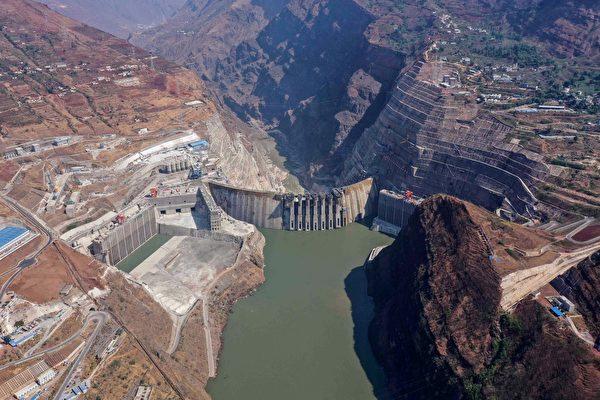The Chinese Communist Party (CCP) recently began the construction of a large hydroelectric power station on the Jinsha River, located within the borders of Dege County in Tibet. The project will destroy six local temples and displace two villages, compelling thousands of Tibetan locals to relocate against their will. In response, hundreds of Tibetans converged in front of the Dege County government offices to voice their opposition, only to be forcefully dispersed by law enforcement.
According to a report from the India-based Tibetan-language radio station Voice of Tibet, several videos circulating online show hundreds of Tibetans protesting in front of the Dege County government office. and police violently dispersing them. They demanded authorities cease constructing the Gangtuo Hydropower Station project in Wangbuding Township.
Other videos show government personnel forcibly removing monks from Yinan Temple, despite their fervent pleas and resistance from local Tibetans who were imploring CCP officials to halt the relocation order, which fell on deaf ears.
On Feb. 22, monks from the Wangdui and Yinan Temples, accompanied by residents, resumed their protests on the streets, only to be met with violent aggression from a sizable contingent of police officers. Numerous reports indicate that hundreds of Tibetan individuals were arrested, with many sustaining injuries requiring hospitalization. To suppress exposure to these events, authorities not only quashed dissenting voices but also confiscated the phones of Tibetans and severed local communication networks.
CCP’s Hydropower Projects Will Cause Devastation: Expert
On Feb. 26, Dr. Wang Weiluo, a prominent Chinese hydrologist based in Germany, cautioned the Chinese edition of The Epoch Times that the construction of hydropower plants by the CCP in western regions is resulting in widespread destruction.Mr. Wang highlighted the Jinsha River as one of the three main water sources for the CCP’s “South-to-North Water Diversion” project’s western line. He emphasized the significance of the Gangtuo Reservoir in the CCP’s hydroelectric development strategy for the upstream of the Jinsha River, branding it a project that the CCP is forcefully advancing.
Mr. Wang pointed to alarming incidents illustrating the hazards posed by such projects. He cited two major landslides near the downstream of the Gangtuo Reservoir in 2018, which occurred during the construction of another large-scale hydropower station, the Bolo Hydroelectric Station. The initial landslide resulted in a barrier lake, obstructing the Jinsha River entirely. As water levels rose behind the dam, villages upstream faced submersion, necessitating the urgent evacuation of residents.
Highlighting the precarious nature of the barrier dam, Mr. Wang explained its inability to withstand water pressure, leading to its natural collapse. Subsequent floods ensued, and days later, another landslide occurred, resealing the breached barrier dam, albeit on a larger scale. The accumulated water behind the dam swelled, exacerbating the situation. Despite CCP’s urgent excavation efforts, the natural force of the river formed another flood upon the dam’s collapse.
“According to calculations, the flow rate of this flood was equivalent to a once-in-ten-thousand-years flood of the Jinsha River,” Mr. Wang said. “In the history of the CCP or the 5,000 years of Chinese history, such a once-in-ten-thousand-years flood has never been recorded, especially not in the upstream of the Jinsha River.”
The aftermath of the flood wrought extensive damage, nearly obliterating all bridges within a 500-kilometer (approx. 310-miles) range along the Jinsha River and prematurely retiring two reservoirs in the middle and lower reaches due to the high sediment content, exceeding that of the Yellow River.
Wreaking Havoc on Yangtze River Ecology
The Jinsha River serves as the primary tributary of the upper reaches of the Yangtze River, spanning a total length of 2,162 miles and coursing through Qinghai, Tibet, Sichuan, and Yunnan provinces, delineated into three sections: upper, middle, and lower reaches.Within the framework of its “13 Hydropower Bases,” the CCP has accorded paramount importance to the Jinsha River hydropower base, positioning it as a key energy source for the “West-East Power Transmission” initiative.
This initiative entails harnessing energy resources such as coal and water from China’s western provinces to generate electricity for transportation to coastal regions in the east, aiming to mitigate power shortages.
The CCP has slated over 20 hydropower stations across the Jinsha River basin. Specifically, in the upper reaches of the Sichuan-Tibet section alone, eight cascade power stations, including the Gangtuo, Yanbi, and Yebatan hydropower stations, have been deployed. Additionally, four large-scale cascade power stations have been completed in the lower reaches of the Jinsha River.
The excessive development of hydropower infrastructure has resulted in the segmentation of the Jinsha River by many hydropower stations, forming an extensive reservoir network, which has precipitated issues related to migration and ecological and geological catastrophes, according to the Chinese state-run media, The Paper.
As early as 2014, The Paper published a series of exposés titled “Jinsha River Hydropower Investigation,” uncovering the detrimental impacts of the CCP’s relentless pursuit of maximizing hydropower generation on the river’s ecosystem and highlighting safety hazards. The phenomenon of numerous hydropower stations vying for water resources has exacerbated challenges such as water scarcity in the Yangtze River.
Addressing the proliferation of large-scale reservoirs under construction and operational in the upper reaches of the Yangtze River, Chen Jin, then vice president of the Changjiang Institute of Science, elucidated to the media that these reservoirs typically retain water during two to three months after the flood season annually. The competitive water retention among reservoirs has not only impeded downstream water storage but has also accelerated the onset of the dry season in the lower reaches of the Yangtze River, exacerbating water shortages and impacting various sectors, including shipping.
The ecological repercussions of hydropower projects in the Jinsha River segment have severely damaged the Yangtze River ecosystem. Chinese state media acknowledged in August 2013 that the development of over 20 cascade hydropower stations has transformed the entire main stem of the Jinsha River into a network of interconnected reservoirs, fundamentally altering hydrological characteristics, sediment transport processes, and the structure and function of the ecosystem.
The hydropower stations have not only precipitated direct impacts on aquatic organisms to the point of extinction but have also disrupted water and sediment fluxes in the upper reaches, thereby influencing variations in water and sediment patterns in the middle and lower reaches of the Yangtze River and the distribution of riverine wetland ecosystems.
In July 2014, Chinese media outlet Chengdu Business Daily reported a substantial number of dead fish surfaced along a 100-kilometer (approx. 62-mile) stretch of the Jinsha River, spanning from the Jiaba Reservoir to the Xiluodu Hydropower Station. The deceased fish, comprising local species such as grass carp, carp, Jiangtuan, and silver carp, amounted to tens of tons in quantity.








